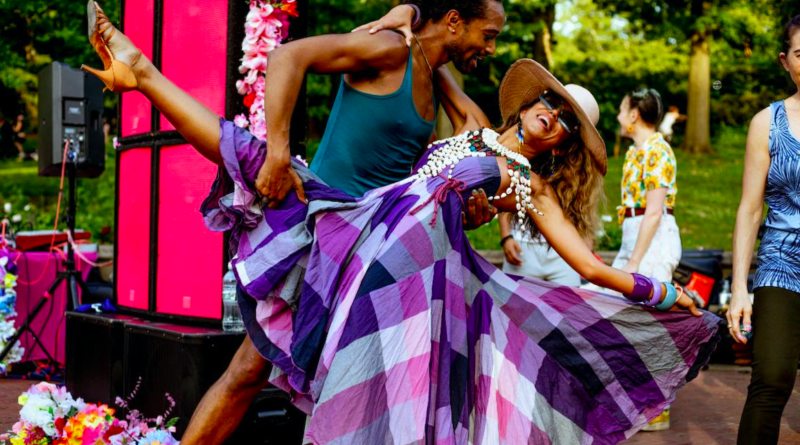INTERVIEW: This Labor Day, ‘Do the Hustle’ at the Guggenheim
Photo: Abdiel performs with Natasha Diggs. Photo courtesy of Lia Clay Miller / Provided by Michelle Tabnick PR with permission.
The Guggenheim Museum’s Works & Process series continues with a special Labor Day performance of Do the Hustle, the dancing extravaganza that celebrates and investigates the hustle, a dance style first popularized in the 1970s disco scene with origins in Latin and African American dances, according to press notes. The piece — created by Abdiel, Joana Matos and Alessandra Marconi — features an interactive performance, dance class and dance party. Chari Glogovac-Smith provides original music.
The hustle is billed as a social dance with no particular gender leading the steps. Historically, the dance brought together queer and straight communities on the dance floor, twirling to the disco beats of the day. Thus, the museum recommends audience members come in “reinvented” disco-era dress.
Abdiel recently exchanged emails with Hollywood Soapbox about Do the Hustle. The choreographer is a former principal dancer of the Martha Graham Dance Company, according to biographical notes. They have performed works by Nacho Duato, Robert Wilson, Sidi Larbi Cherkaoui, Sonya Tayeh, Luca Veggetti, Andonis Foniadakis, Michelle Dorrance, Larry Keigwin, Doug Varone and Richard Move. Abdiel teaches their gender neutral approach to partner touch dance at several schools, and the hustle is a major part of their artistry and scholarly focus. Questions and answers have been slightly edited for style.
What can audiences expect at Do the Hustle?
In this first iteration, audiences can expect to be taken through a succinct history lesson of the hustle and a short dance class and dance party as an invitation to dance and to do the hustle.
When did you first learn about (and fall in love with) the hustle?
I first learned about the hustle in the ballroom dance world when I was a teenager teaching ballroom dance at Arthur Murray Dance Studios. However, it was the codified, heteronormative, white-washed version that was made popular through mass-commercialization in the late ’70s. I was not at all that interested in that version. When I discovered the hustle in NYC years later, I was taken away by the dynamism, creativity and individuality of a diverse multigenerational group of people of varied races, ethnicities, sexual orientation and ages that I had not witnessed previously. There was so much joy and freedom of expression within the dance. As a queer, genderfluid person of color, I was looking for a space and community where I could express my fullest self, and surprisingly through the hustle I was able to and was celebrated for it.
Did the history of the dance inform your work?
Yes! This work is created by a team of collaborators led by myself, Alessandra Marconi and Joana Matos. The history directly guides the work, and my role specifically as the host is to guide the audience through that history. The show currently is a condensed retelling of the evolution of the hustle throughout the ’70s decade that we imagine from the information we have gathered about the dance today from various sources including videos, photos, interviews and conversations from older generations of community members, etc.
I am currently engaged in research on the history of the hustle as a graduate student at University of Washington and have been collecting historical information through oral history with various older generations of hustle dancers in the community that experienced and contributed to the early development of the hustle throughout the ’70s. I have become sort of a dramaturg in the creative process to make sure the script and scenes align with as much historical integrity we have access to with the information we currently have on the dance and the research I have personally conducted thus far, which is still in process and evolving. It’s important to note that this presentation does not represent all viewpoints and experiences within the community.
How important is it that this dance has a non-gendered lead-form?
The traditional roles of leader and follower are not gender specific. Because of this, it allows for a free-flowing, fluid interchange between dancers where you get to decide whatever role you want to dance despite your gender identity. I believe this is important in creating more possibilities for exploration and creativity between people rather than being fixed in one perspective or one role.
What’s it like working with Joana Matos and Alessandra Marconi?
I met both Joana and Alessandra in the hustle dance community social dancing, so we are all a part of the hustle community. In fact, all our collaborators are new and longtime members of the hustle community. That’s what makes this creation special, that it is made by those within the actual dance community represented, so we come to this work with a common language that connects and unites us.
What’s the future for this “work in progress”?
I don’t know yet. In any case, I intend to continue research, discussion and creation around hustle’s history, evolution and current resurgence.
By John Soltes / Publisher / John@HollywoodSoapbox.com
Do the Hustle is part of the Guggenheim’s Works & Process series. The performance will be presented Monday, Sept. 5 at 7:30 p.m. Click here for more information and tickets.

